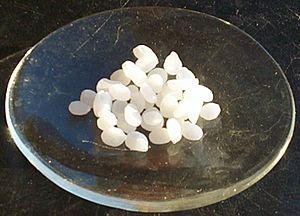Alkali facts for kids
In chemistry, an alkali is a special kind of liquid solution that has a pH value higher than 7. Think of it as the opposite of an acid.
The word 'alkali' comes from an old Arabic word, 'qali', which means 'from the ashes'. This is because people used to mix ashes with water to make cleaning products, like soaps, and these mixtures were alkaline.
An alkali is formed when a base dissolves in water. Many alkalis are also salts of Alkali metals. You can make an alkali less strong, or 'neutralize' it, by adding an acid. This brings its pH closer to 7, which is neutral.
Contents
What Are Alkalis Like?
Alkalis have several interesting features:
- They often feel soapy or slippery to the touch.
- Strong alkalis are corrosive. This means they can damage or burn your skin, so be careful!
- The higher the pH number is above 7, the stronger the alkali.
- Most alkalis can easily dissolve in water.
- They can have a bitter taste, but you should never taste them!
- Alkalis turn red litmus paper blue.
- They can conduct electricity because they have tiny charged particles called ions moving around in them.
- When you use a universal indicator to test an alkali, it will turn blue or purple.
How Strong Are Alkalis?
Just like acids, alkalis can be either weak or strong. Their strength depends on what they are made of and how much of the alkali is dissolved in the water. We use the pH scale to measure how strong an alkali is.
For example, everyday items like soap and toothpaste contain weak alkalis. On the other hand, many cleaning products, like oven cleaners, contain very strong alkalis.
Common Alkalis You Might Know
Here are some alkalis you might come across:
- Sodium hydroxide (NaOH)
- Potassium hydroxide (KOH)
- Calcium hydroxide (Ca(OH)2)
- Aqueous ammonia (NH3 (aq))
How Are Alkalis Used?
Alkalis are used in many different ways:
- Sodium hydroxide is important for making paper, detergents, and soap.
- Potassium hydroxide helps farmers make acidic soil less acidic, so plants can grow better. It's also used in some batteries.
- Calcium hydroxide is also used to make acidic soil neutral.
- Ammonium hydroxide is a common ingredient in many cleaning products.
Oxides and Hydroxides
Metal oxides and metal hydroxides are two types of bases. When you add an acid to them (neutralize them), they create a salt and water. The type of salt that forms depends on the specific acid and base you use.
See Also


